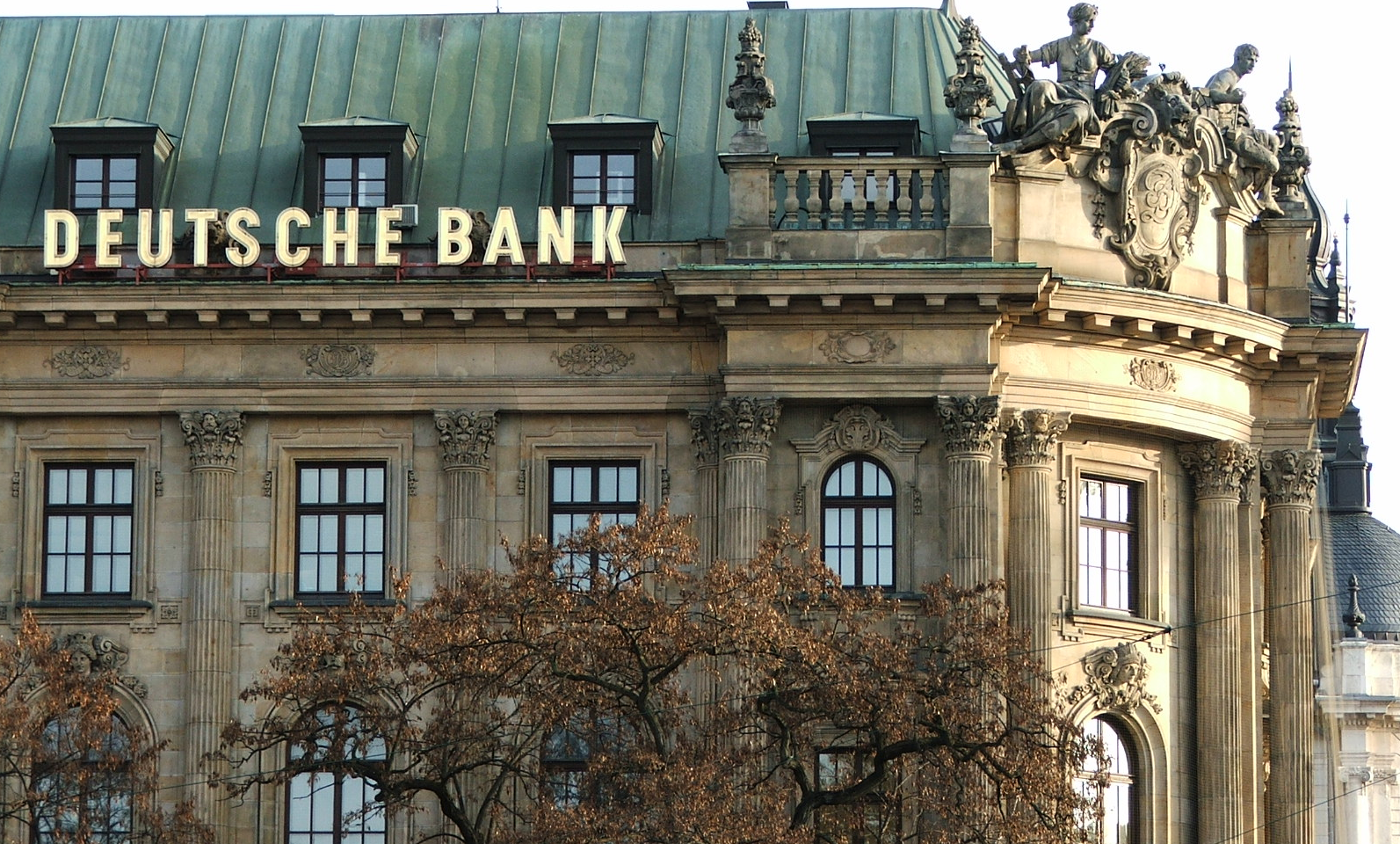Is Deutsche Bank The Beginning of the Zombie Apocalypse?

It’s a close call to pick the top contender for “Crisis of the Year.” This Deutsche Bank (DB) drama is fresh on the heels of Brexit. Before that, it was the “third round of Grexit” panic . Another wave of potential Brexit chaos seems inbound, but now with worries over a quicker and more disorderly departure from the EU.
Just when you thought we could fall back into our comfortable routine of hand-wringing over China’s hockey stick rate of debt buildup and real estate bubbles, Germany chimes in with an impressive entry of its own.
Germany is that strange economy that Europe can’t seem to live with or without, and is now providing us with the latest global financial horror show in the form of renewed doubts over the stability of its largest lender, Deutsche Bank (DB).
Let’s cut to one important point first: there’s no need to panic – yet. Deutsche Bank is not likely going to pull a Lehman Brothers for the simple fact that we all now know how painful a major bank collapse can be, and Deutsche is more “major” by about 3 times.
Deutsche Bank is the largest bank not only in Germany, but in all of Europe. Its balance sheet is nearly the size of the entire Australian economy, and its outstanding derivative contracts net of offsets and hedges is roughly $41 trillion. For perspective, that’s nearly twice the size of the US economy. It definitely qualifies as “too big to fail,” yet for now at least, it’s still undecided as to who exactly is going to step in to save it.
There are a few big questions the DB drama raises that should have us all losing at least a little sleep at night:
Why Must We Keep Getting Blindsided by the Balance Sheets of Massive, Systemically Critical Financial Institutions?
 Numbers are meant to give a sense of certainty to a company’s report – the concrete foundation you can rely upon to speak at least a modicum of truth once you get past the CEO’s letter to the shareholders and all the other fluff. Unfortunately, as with statistics, they can be tortured to tell a wide range of stories while still conforming to GAAP (Generally Accepted Accounting Principles) standards.
Numbers are meant to give a sense of certainty to a company’s report – the concrete foundation you can rely upon to speak at least a modicum of truth once you get past the CEO’s letter to the shareholders and all the other fluff. Unfortunately, as with statistics, they can be tortured to tell a wide range of stories while still conforming to GAAP (Generally Accepted Accounting Principles) standards.
Deutsche Bank has, at first glance, a respectable balance sheet. Those who jump straight to the debt to equity ratio will note a cocky $1.8 trillion balance sheet teetering on a wafer thin $68 billion of equity. That amounts to an over-ambitious leverage ratio of 25:1.
Without going too far into the banking weeds, when you add in items like retained earnings, liquid instruments readily for sale and other low-risk debt securities, you arrive at what’s referred to as tier 1 capital. The ratio of a bank’s tier 1 capital against its risk-weighted assets is one of the most important measures of a bank’s financial strength. It is heavily regulated and closely watched by markets.
Deutsche currently clocks in around the 11 percent mark on this measure. That sounds bad, when you consider that Lehman had just hit 11.2 percent in September 2008 before “the big one” hit.
But then, it doesn’t sound that bad when you consider that the big four Aussie banks all stroll in around the 10 percent mark as of today. There’s also the fact that Deutsche is sitting on an impressive $200 billion plus pile of cash, with the assurance of unlimited liquidity to be provided by the Bundesbank (Germany’s central bank) in the event of a cash crunch.
So What on Earth is Going on Here?
 The problem is that nobody knows exactly what, and that’s bad for a business that depends entirely on the trust of its counterparties to perform multiple, complex, interdependent and systemically vital transactions on a second by second basis. Some are questioning the quality of its long-term assets, and wonder what dead bodies may lurk in its outsized derivative book. That raises the spectre of whether the “risk adjusted” part of its capital ratio is an accurate reflection of what’s going on.
The problem is that nobody knows exactly what, and that’s bad for a business that depends entirely on the trust of its counterparties to perform multiple, complex, interdependent and systemically vital transactions on a second by second basis. Some are questioning the quality of its long-term assets, and wonder what dead bodies may lurk in its outsized derivative book. That raises the spectre of whether the “risk adjusted” part of its capital ratio is an accurate reflection of what’s going on.
There are three things the market does know for sure that are definitely not good:
- The bank is about to have its tier 1 capital eroded further by whatever settlement it makes with the US Department of Justice (DOJ) over its recent $14 billion fine.
- The bank was having trouble reaching acceptable levels of profitability even prior to this.
- Most ominous of all, DB is now receiving requests from counter parties to withdraw collateral on deposit for execution of derivative trades.
Number three is the “we actually think you might be going down” signal. It’s the first whiff of what amounts to an institutional run on a bank. This has sent the bank’s share price into a nosedive, and it currently trades well below the lowest levels seen in the darkest days of 2008. The stock price is so low, that it now trades for around 25 percent of book value.
That is an astonishing number. The market could be collectively saying that it believes you could value DB’s business at zero, send in the liquidators, and you’d only get 25 cents on the dollar for their net assets at auction, even with that massive pile of cash to cushion any losses. Being too big to fail, central bankers are not likely to allow that to happen however, and DB needs to either become profitable again and begin rebuilding its tier 1 capital (and it hasn’t yet convinced anyone it’s capable of doing so), or it is going to be subjected to some form of restructuring – one that is unlikely to end well for current equity holders.
In short, we don’t have a liquidity problem here. We have what looks very much like a long term profitability issue, which is being priced by the market as severe enough that it might in fact be a long term solvency issue. This is the opposite of what most banks claimed during the GFC.
When you have solvency issues papered over by endless liquidity, you get “Zombie” institutions – banks and companies that shouldn’t be alive by natural law but somehow keep moving about, feasting on the flesh of the living. Zombies are bad for an economy long term, because they’re typically kept alive for systemic or political reasons and are thus hard to kill once created. They just hang around, sucking up resources with little incentive to get back into shape because they have an indefinite lifeline to lean on.
How did this creep up on everyone, and why has this only begun to make headlines in the past six months? One reason is because it’s not easy to read what is happening in the financial reports of major banks. Common ratios and metrics can be misleading, and it’s only when a catalyst arises to get the analysts and fund managers looking under the hood that the dead bodies are found.
And by that time, they’ve already begun to smell.
How Does Germany Talk Its Way Out of this One?
 I’ve got a lot of sympathy for the German voter.
I’ve got a lot of sympathy for the German voter.
Australian voters are quick to rage when the subject of dole bludgers at home becomes the headline du jour. I won’t even approach the topic of asylum seekers (and Germany has several times its fair share of those as well).
Imagine for a moment however that it was not only unemployment benefits at home sucking up your tax dollars, but also an entire continent of foreign nations surrounding you that you were also expected to prop up?
As previously written, I still feel in the long run the political and economic cocktail that is the Eurozone only ends badly for the simple fact that while Germany’s export economy has benefited hugely from its role in the EU, that is not an easy message to convey in the face of simpler opposing narratives. The Merkel administration has done astonishingly well holding the project together in the face of an increasingly impatient electorate, but between Greece and the current refugee crisis it has all but depleted its political capital.
Openly the Merkel administration has insisted that a public bailout is not on the table for Deutsche Bank, which has only mildly higher approval ratings among the German electorate than another bailout for Greece. Capitulating on either at this point is widely commentated as being almost certainly fatal to their next re-election bid. The alternative however, a “bail-in” whereby equity and bond-holders get slugged for the expense of any recapitalization effort has a much more appealing ring to the public.
Unfortunately it does come with some thorny and incredibly unpredictable problems. Such a bail-in would trigger a re-rating of financial institutions across the continent and around the world by setting a new precedent for dealing with the too-big-to-fail issue.
Investors would be jolted into a new reality where they are now in effect fully exposed to whatever level of risk taking is occurring inside a financial institution in which they hold debt or equity. Lenders already operating on thin margins due to low interest rates and stiffer regulatory requirements would see capital costs surge, squeezing profits further still.
How far this contagion could spread is impossible to predict, as is the possibility that it may trigger collapses in systemically vital institutions elsewhere, rapidly setting off yet more land mines in an unpredictable daisy chain a la October 2008.
The Fed made a bet when it allowed Lehman to fail that the carnage would be contained, and it would teach the market a stiff lesson on the unwillingness of central banks and governments to indefinitely underwrite the downside of their risk taking. It obviously went wrong on a Chernobyl order of magnitude, and the bet being considered with a bail-in of Deutsche Bank sounds ominously similar. What to do?
Could the Same Thing Happen to an Australian Bank, and If So Could It Be Saved?
 The answers are yes, and probably no; at least not without some help from a supranational organization such as the IMF.
The answers are yes, and probably no; at least not without some help from a supranational organization such as the IMF.
To be clear: I am not predicting this will happen. I am however saying in no uncertain terms that it is not impossible for it to happen. Contrary to popular myth, Australia is not magic, nor are its bankers or politicians any smarter than their American, British or continental counterparts.
Referring back to the first disturbing question this article posed, the difficulty lies in the very nature of understanding financial institutions operating in a fractional reserve banking system. Fractional banking makes it inevitable that any licensed financial institution legally allowed to conjure money will do so to the highest extent allowed first by regulators, then by markets. They do this because the more they lend, the more they profit. If they lag on lending, their profits drop, along with their share price. If that happens, the heads of senior management roll.
Looking at the balance sheet of CBA (not to pick on them, all the big four have similar issues), they appear safer at first glance because their basic leverage ratio is around 15:1 (rough numbers here). As mentioned earlier, when you factor in all of their tier 1 capital it translates to 10 percent or so, which is within current regulatory requirements but will need to be beefed up as new rules are introduced in coming years.
There are some other important differences between DB and CBA:
- First, CBA doesn’t appear to have a great deal of cash or equivalents on hand relative to their current liabilities; certainly nothing close to what Deutsche has. This is bad, because it means in a cash crunch they’re going to need to sell stuff quickly or rely on outside sources to remain liquid.
- Second, CBA doesn’t seem to be playing with derivatives in the way Deutsche does. Yes, they do securitize many of the loans they originate, but that’s pretty tame stuff by comparison. This is a good thing as it removes a degree of uncertainty over the quality of their assets – although it does not guarantee that they have been risk-weighted accurately.
- Third, the CBA has a massive reliance (as do all the big four banks) on external short term funding. A peek at their latest annual report shows $588 billion in “Deposits and public borrowings”. That’s money that can come or go very quickly with the ebb and flow of public confidence.
All that said, CBA remains very profitable, something Deutsche can’t currently claim, and trades at an incredibly healthy two-times its book value. Interestingly, it also trades at an implied 8 percent gross dividend yield, which is extremely high for a blue chip financial. It’s high enough in fact that it implies a level of market expectation that the dividend could be cut in the near future, something banks are loathe to do as it carries the stigma of signalling weakness. This could be a hint that just like DB’s 0.25 price-to-book ratio, the market suspects “something is up”.
Could CBA be saved in a Deutsche-esque scenario? It depends. On its own, probably. However, CBA is linked incredibly closely to the other major Australian banks. In the more likely event it drags down one or more of the others, you’re looking at a combined mess twice the size of Deutsche in an economy a third as large as Germany’s. In that scenario, the problem would easily overwhelm the federal budget, and you’d need the IMF, or an outright nationalization to keep the lights on.
So far, there’s no sign of that on the horizon, thanks to the confidence of short-term lenders in the quality of the long-term assets on CBA’s balance sheet. On that front, let’s hope Aussie real estate values never do revert to their long term price trend.
Final Thoughts – The Toxic Cocktail of Modern Finance:
 The issue facing Deutsche is so similar to 2008 in essence that it boggles the mind. Deutsche is not Lehman – it is in far better shape; at least on paper.
The issue facing Deutsche is so similar to 2008 in essence that it boggles the mind. Deutsche is not Lehman – it is in far better shape; at least on paper.
The problem itself is the same: we have highly leveraged banks, with arcane balance sheets populated by even more arcane assets and liabilities, governed by risk weighting models that get adjusted every few years because they haven’t got enough sample data in them to accurately predict the likelihood of a bad outcome. It’s all based on trust, and when the trust goes, it doesn’t matter what your balance sheet looks like.
Further to this, the hyper-interconnected nature of the modern financial system makes contagion impossible to prevent. Leverage + opacity + interconnectedness + systemic importance all become force multipliers that feed on each other once the chain reaction has begun.
Are you having trouble understanding all of this? If so, that’s exactly how they like it. The less the average person understands, the longer they can keep the charade going.
I doubt Deutsche Bank will trigger the next GFC. It will be bailed out, or bailed in. There may be a Bear Stearnes-esque negotiated merger or takeover. However it is resolved, it will not cure the underlying problem of the above equation. Raising capital adequacy requirements has been tried, and unfortunately it appears that a problem as complex as this does not have quite so easy a fix.
If Deutsch Bank were a personal computer, we’d probably just kick it before hitting the reset button.
Comments
Got something to say? Post a comment...
You must be logged in to post a comment.





Great insights Aran.
Australian bank profitability is highly dependent on strength in our housing market. Where do you see the tipping point where banks really start to get in trouble if property values ever decline? 20% decrease in home values? 30%? And how likely do you think that scenario is?
Port Headland, Karratha & surrounding areas in WA have already drop 45%.
True, and for homeowners and investors in those cities, I’m sure it’s tough if they bought at the highs. But those markets make up a relatively small percentage of the national market, so the banks will have minimal exposure there. To be more precise, my question to Aran relates more to the Sydney and Melbourne markets, and perhaps Brisbane, which make up the vast majority of the exposure of the banks.
Profitably starts to crater well before the 20-30% decline mark, but on its own it’s not the end of the world (although virtually everyone would feel the pain via share exposure in their super funds).
A large drop in housing prices could probably be absorbed so long as it isn’t accompanied by a spike in unemployment and default rates. I’m only speculating, but my guess is that the combination of those factors would be enough to spook foreign creditors, which is the primary vulnerability in the Aussie banking picture.
That would mean a shock reassessment of the long term assets of the Big Four and the fundamental viability of their business models. This is what DB is currently struggling with, and they are in considerably better financial shape to deal with it than are the Aussie banks.
In short: As long as everyone nods and says it’s all cool, it’s all cool.
Good article.
Aran, this is a brilliant article! Thanks
Yes, great article, thank you.
Great article and even better summary in the comment, Aran:
> In short: As long as everyone nods and says it’s all cool, it’s all cool.
Ha-ha, sounds like an old mantra of a modern world economy.